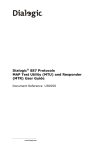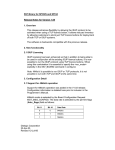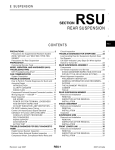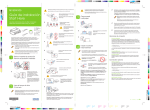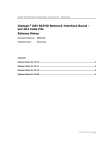Download Issue 3 - Dialogic
Transcript
Dialogic® SS7 Protocols SCCP Sub-System Monitor (SSM) User Guide Document Reference U28SSS Section 1 Introduction Copyright © 2005-2007 Dialogic Corporation. All Rights Reserved. You may not reproduce this document in whole or in part without permission in writing from Dialogic Corporation. All contents of this document are furnished for informational use only and are subject to change without notice and do not represent a commitment on the part of Dialogic Corporation. Reasonable effort is made to ensure the accuracy of the information contained in the document. However, Dialogic Corporation does not warrant the accuracy of this information and cannot accept responsibility for errors, inaccuracies or omissions that may be contained in this document. INFORMATION IN THIS DOCUMENT IS PROVIDED IN CONNECTION WITH DIALOGIC® PRODUCTS. NO LICENSE, EXPRESS OR IMPLIED, BY ESTOPPEL OR OTHERWISE, TO ANY INTELLECTUAL PROPERTY RIGHTS IS GRANTED BY THIS DOCUMENT. EXCEPT AS PROVIDED IN A SIGNED AGREEMENT BETWEEN YOU AND DIALOGIC, DIALOGIC ASSUMES NO LIABILITY WHATSOEVER, AND DIALOGIC DISCLAIMS ANY EXPRESS OR IMPLIED WARRANTY, RELATING TO SALE AND/OR USE OF DIALOGIC PRODUCTS INCLUDING LIABILITY OR WARRANTIES RELATING TO FITNESS FOR A PARTICULAR PURPOSE, MERCHANTABILITY, OR INFRINGEMENT OF ANY INTELLECTUAL PROPERTY RIGHT OF A THIRD PARTY. Dialogic products are not intended for use in medical, life saving, life sustaining, critical control or safety systems, or in nuclear facility applications. It is possible that the use or implementation of any one of the concepts, applications, or ideas described in this document, in marketing collateral produced by or on web pages maintained by Dialogic Corporation or its subsidiaries may infringe one or more patents or other intellectual property rights owned by third parties. Dialogic Corporation does not provide any intellectual property licenses with the sale of Dialogic products other than a license to use such product in accordance with intellectual property owned or validly licensed by Dialogic Corporation or its subsidiaries and no such licenses are provided except pursuant to a signed agreement with Dialogic Corporation. More detailed information about such intellectual property is available from Dialogic Corporation’s legal department at 9800 Cavendish Blvd., Montreal, Quebec, Canada H4M 2V9. Dialogic Corporation encourages all users of its products to procure all necessary intellectual property licenses required to implement any concepts or applications and does not condone or encourage any intellectual property infringement and disclaims any responsibility related thereto. These intellectual property licenses may differ from country to country and it is the responsibility of those who develop the concepts or applications to be aware of and comply with different national license requirements. Dialogic is a registered trademark of Dialogic Corporation. Dialogic's trademarks may be used publicly only with permission from Dialogic. Such permission may only be granted by Dialogic’s legal department at 9800 Cavendish Blvd., 5th Floor, Montreal, Quebec, Canada H4M 2V9. Any authorized use of Dialogic's trademarks will be subject to full respect of the trademark guidelines published by Dialogic from time to time and any use of Dialogic’s trademarks requires proper acknowledgement. Windows and Visual C++ are registered trademarks of Microsoft Corporation in the United States and/or other countries. Other names of actual companies and products mentioned herein are the trademarks of their respective owners. Publication Date: October 2007 Document Number: U28SSS, Issue 3 2 SCCP Sub-System Monitor (SSM) User Guide Issue 3 Revision History Issue Date Description A 03-Oct-01 Initial Issue 1 15-Feb-02 Updated after review 2 31-Jan-03 Branding changed: Septel PCI now SPCI4/SPCI2S and Septel cP now CPM8. 3 01-Oct-07 Changed copyright to Dialogic Corporation. Remove reference to PCCS6, include non-circuit protocol configuration commands in config.txt and add support for SIGTRAN M2PA links. 3 Section 1 Introduction Contents 1 Introduction......................................................................................................................................... 5 1.1 Software requirements ...................................................................................................................... 5 2 SSM Application ................................................................................................................................. 6 2.1 SSM Messages ................................................................................................................................. 7 2.2 Concerned Relationships .................................................................................................................. 8 2.3 Customising the SSM Application ..................................................................................................... 9 2.4 SSM source code .............................................................................................................................. 9 3 Building the SSM applications ........................................................................................................ 10 3.1 Host software directory structure..................................................................................................... 11 3.2 Building SSM ................................................................................................................................... 11 4 Configuration .................................................................................................................................... 13 4.1 System Configuration ...................................................................................................................... 13 4.1.1 SPCI2S, SPCI4 and SS7HD ........................................................................................................ 13 4.1.2 SIGTRAN M2PA........................................................................................................................... 13 4.1.3 SS7G2x ........................................................................................................................................ 13 4.2 Protocol Configuration ..................................................................................................................... 14 4.2.1 SCCP............................................................................................................................................ 14 5 Running the SSM application.......................................................................................................... 15 5.1 SSM Command Line Arguments..................................................................................................... 15 6 References ........................................................................................................................................ 16 7 Abbreviations.................................................................................................................................... 17 Appendix A - Example SSM Configuration Files.............................................................................. 18 A.1 A.1.1 A.1.2 A.2 A.2.1 A.2.2 A.2.3 A.3 A.3.1 A.3.2 system.txt.................................................................................................................................. 19 system.txt for point code 1........................................................................................................ 19 Running SSM with SS7HD ....................................................................................................... 21 config.txt ................................................................................................................................... 23 config.txt for point code 1 ......................................................................................................... 24 config.txt for point code 2 ......................................................................................................... 25 Using different operating systems and board configurations ................................................... 26 SCCP Configuration files.......................................................................................................... 27 set_pc1.ms7 ............................................................................................................................. 27 set_pc2.ms7 ............................................................................................................................. 28 Appendix B - Sample Output.............................................................................................................. 29 4 SCCP Sub-System Monitor (SSM) User Guide Issue 3 1 Introduction The Dialogic® SCCP Subsystem Monitor (SSM) is an example application for demonstrating the use of the Dialogic® SCCP module. This user guide describes the design, building and usage of this application for developers. The SSM demonstrates the behavior of the SCCP module by offering simple functionality while showing real examples of the interface to the module. The SSM application can also be used to provide simple verification of system configuration and set-up. This user guide is intended for users who choose to develop their own applications that will interface with and use the functionality provided by the SCCP module. 1.1 Software requirements The SSM application requires the following software: 1. Dialogic® SS7 Development Package 2. Dialogic® User Part Development Package 3. For TDM-based configurations: • ss7.dc3 or ss7.dc4 codefile • Dialogic® MTP3 and SCCP host binaries, as required 4. For SIGTRAN-based configurations: • Dialogic® M2PA, MTP3 and SCCP host binaries, as required Software can be downloaded from http://www.dialogic.com/support/helpweb/signaling/software3.htm 5 Section 2 SSM Application 2 SSM Application The monitor itself is configured as a subsystem at a signaling point that will monitor other resources, via the SCCP management messages, which have been configured at either the local or remote signaling points. This test tool is capable of the following : • Configure itself as a subsystem (command line optional). On the Dialogic® Signaling Interface Unit (SIU) this must be done in the config.txt file. • Set up concerned relationships between monitor and local subsystem(LSS), remote subsystem (RSS) and the remote signaling point (RSP) • Monitor the state of LSS/RSS/RSP • Check initial status of LSS/RSS/RSP • Return SCCP version information • Run in a console or shell window SSM SSM LSS Figure 1. RSS SCCP-CL SCCP-CL MTP3 MTP3 MTP2 or M2PA MTP2 or M2PA Point Code 1 Point Code 2 Necessary SS7 layers when running SSM SSM needs to run at both ends only if remote subsystems are to be monitored. This is due to the concerned relationships that need to be set up (see section 2.2 Concerned Relationships). The LSS/RSS can be any application, s7_log for example. 6 SCCP Sub-System Monitor (SSM) User Guide Issue 3 2.1 SSM Messages A number of messages are sent out to SCCP from the SSM. Below is a list of messages sent by SSM and their purpose. a) GEN_MSG_MOD_IDENT (0x6111) This message is used to retrieve the SCCP module version and textual description. After this message has been sent, a message is displayed showing the SCCP version information, e.g. SSM: V3.09 SS#7 SCCP b) SCP_MSG_CNF_SSR (0x7741) This message will configure the SSM as a local subsystem at the signaling point. SCCP will not send any messages to a resource for which it has not received a configuration message. The displayed message depends on whether the SSM was successfully configured as a subsystem, e.g. SSM: Monitor configured as subsystem If the monitor could not be configured successfully, a message will appear indicating this. c) SCP_MSG_R_SSR_STATS (0x6753) One of these messages is sent for each local subsystem (not SSM), remote subsystem and the remote signaling point. It returns the current status of the resource, either ‘allowed’ or ‘prohibited’. For the remote signaling point, the message displayed might be: e.g. SSM: Remote pt. code 0x0002 : status allowed d) SCP_MSG_ADD_CONC (0x7743) This message is used to set up a concerned relationship. One of these messages is sent for a relationship between the monitor and the local subsystem. A second message is sent for the relationship between the monitor and the remote signaling point. To monitor the remote subsystem two messages are required ((3) + (4) in 0). One message is sent for a relationship between the monitor and the remote subsystem. The other message is a concerned relationship between the local subsystem and the remote signaling point. This last message has no effect if SSM is only run at one end. These concerned relationships can be seen on the following page in 0. When a concerned relationship message is sent, a message is displayed depending on whether the relationship is successful, e.g. SSM: Remote subsystem 0x0c not added as concerned resource – error 0x06. Information on the error codes can be found in the programmer’s manual[1]. 7 Section 2 SSM Application 2.2 Concerned Relationships SCCP has functionality that allows a node in a network to be informed of a change in status of another node in the network. In this case, relationships are set up to ensure that the SSM is informed of any status change in the LSS, RSS or RSP. SSM1 LSS SSM2 RSS (1) (4) (2) (3) Figure 2. SP 1 SP 2 LSP RSP Example of concerned relationships Below is a list detailing the concerned relationships shown in 0. (1) SSM1 is concerned about status of LSS (2) SSM1 is concerned about status of RSP (3) SSM1 configures SCCP at SP 1, to pass messages about RSS status up to itself (4) SSM2 configures SCCP at SP 2, to pass messages about LSS to the RSP As mentioned previously, SSM1 and SSM2 will both need to be run if you wish to monitor the RSS. This is mainly due to the way in which relationships (3) and (4) above are intended to work. Concerned relationship (3) will pass information regarding the status of the RSS up to the monitor. But this can only work if SP 2 is configured to pass information about its LSS to SP 1. SP 2 can not be configured in this way by SSM1. So if SSM2 runs also, and both SSM1 and SSM2 configure their local signaling point to send messages about the status of its LSS, each signaling point can know the status of their RSS. If the signaling points at both ends are correctly configured, SSM at both ends should respond to any changes in the status of local/remote subsystems and remote point codes with messages like those below, e.g. SSM: subsystem 0x0c at pt. code 0x0002 – PROHIBITED SSM: pt. code 0x00000002 – PROHIBITED 8 SCCP Sub-System Monitor (SSM) User Guide Issue 3 2.3 Customizing the SSM Application SSM is example code for development using the Dialogic® SCCP module and as such, a number of simplifications and limitations have been imposed for this purpose. SSM will only allow one subsystem (apart from itself) to be configured at a signaling point. SSM is only designed to work between 2 signaling points. The developer should be aware of the limited nature of the example application when making use of the source code for building their own application. 2.4 SSM source code The SSM program can be found in the Dialogic® User Part Development Package. The following table describes the files required by the SSM application: File Notes ssm_main.c This file contains the main() function. This reads the command line arguments and passes them to ssm_ent(). ssm.c First, if the –c command line option a call is made to SSM_config_res() to configure SSM as a subsystem. SSM then calls SSM_initialise() which will retrieve the initial status of point codes and subsystems, set up concerned relationships and retrieve the SCCP module version dependent on the command-line options provided. The main loop of SSM is contained in SSM_main_process() which checks for any messages received. 9 Section 3 Building the SSM applications 3 Building the SSM applications Example make-files for the following operating systems are provided and identified by a unique suffix: Operating system Suffix Generic UNIX (Solaris, Linux) .mak Windows ® .mnt A single definitions file (one for each operating system) which contains the definitions relating to the user’s own development environment is supplied in the Dialogic® User Part Development Package. The definitions files are as follows and the appropriate file should be used depending on the operating system: makdefs.mak (Linux) makdefs_sol.mak (Solaris) makdefs.mnt (Windows®) For Windows®, a dynamically linked GCT library that allows the application to link to the GCT functions is supplied in the Dialogic® SS7 Development Package as follows: gctlib.dll (Visual C++® compiler) For ‘UNIX’, a GCT shared object is supplied in the Dialogic® SS7 Development Package e.g. libgctlib.so.1.0.0 (Linux & Solaris) The source code for the example program should be compiled and linked with the appropriate library for the operating system in use. 10 SCCP Sub-System Monitor (SSM) User Guide Issue 3 3.1 Host software directory structure To build the SSM application, the user should first ensure that the required files are copied into the correct directories as follows: 1. Copy either the zip or tar file from the Dialogic® User Part Development Package to the Dialogic® SS7 Development Package directory and decompress using the appropriate tool. The choice of the zip or tar file is up to the user; both will create the UPD directory structure shown in the table below. The table below shows files required by the SSM program only. 2. The C header files in the INC directory shown in the table below lists the header files required by the SSM program. The following table lists the directory structure and files required to build the SSM program supplied on the Dialogic® User Part Development Package. Root directory Septel INC UPD scp_inc.h msg.h pack.h ss7_inc.h strtonum.h sysgct.h system.h asciibin.h BIN SRC BACKUP_BINWIN SSM BACKUP_BINLNX ssm.mnt ssm.mak ssm_sol.mak ssm.c ssm_iss.txt ssm_main.c BACKUP_BINSO L makdefs.mnt makdefs.mak makdefs.mak makeall.bat makeall makeall_sol 3.2 Building SSM It is assumed that the UPD is extracted in the Dialogic® SS7 Development Package directory i.e. for Windows® C:\Septel as shown above. Similarly, for Linux, a symbolic link should be created it is assumed that the UPD is unpacked and stored within in the DPK directory. A script is provided in the BIN\SRC directory to build and copy all of the example programs into the UPD/BIN directory. To run this script, change to the BIN\SRC directory and type one of the following commands depending on the operating system: makeall (Linux) makeall_sol (Solaris) makeall.bat (Windows®) A pre-built copy of the SSM application, for each operating system, can be located within the backup subdirectories in the BIN directory. 11 Section 3 Building the SSM applications To build the SSM program, change to the SRC\SSM directory and type one of the following commands depending on the operating system: make –f ssm.mak make –f ssm_sol.mak nmake /f ssm.mnt 12 SCCP Sub-System Monitor (SSM) User Guide Issue 3 4 Configuration The local and remote ends of the system need to be configured before the SSM application may be run. Example configuration files are provided in the Dialogic® User Part Development Package and after installation will be stored in the directories as shown in the following table: Root SSM SSM “CONFIG” “CONFIG” config.txt config.txt system.txt system.txt Example configurations for TDM and SIGTRAN are provided. The configuration files in the SSM directories should be copied to the appropriate node. Refer to Error! Reference source not found. Error! Reference source not found. for further information. 4.1 System Configuration The GCT environment is configured using the gctload program and the system.txt file. The basic board configuration along with the Dialogic® MTP and SCCP modules is achieved using the config.txt file. 4.1.1 SPCI2S, SPCI4 and SS7HD For TDM-based configurations, example board based configuration files are provided in Appendix A for SSM. When running SSM on a Windows® host system using an SPCI4 board with the Dialogic® MTP3 and SCCP modules running on the host, the example configuration files provided in Error! Reference source not found. may be used without any modification. Configuration details for other board types are also provided for reference. 4.1.2 SIGTRAN M2PA It is also possible to run the SSM application from 2 hosts connected in back-to-back with SIGTRAN M2PA links. 4.1.3 SS7G2x System and protocol information is configured using the management module and commands in the config.txt and system.txt files for the SS7G2x. Further information on this can be obtained from the user manual Error! Reference source not found.. Note: These files are not contained in the User Part Development Package. 13 Section 4 Configuration 4.2 Protocol Configuration All protocol modules are configured using commands in the config.txt file. The example configuration files given in the appendices will perform the appropriate protocol configuration shown below. If the user wishes to better understand or alter the configuration given, the following sections will be of interest. Before configuring the protocol modules it is useful to determine the following information relative to each network entity: • Local point code • Local sub-system number • Remote point code and • Remote sub-system number 4.2.1 SCCP The local point code and configuration options (e.g. for ITU-T or ANSI operation) are contained in the main SCCP configuration message and should be set to the appropriate value as described in the programmer’s manual[1]. In addition, configuration messages are required for the local subsystem, remote point code and remote subsystem. 14 SCCP Sub-System Monitor (SSM) User Guide Issue 3 5 Running the SSM application Before running the Dialogic® SSM application, the GCT environment must first be initialized and the signaling links brought into service. This is achieved by running the gctload program and activating the links using the mtpsl utility. Refer to manuals [3], Error! Reference source not found. or [3] for details as appropriate. 5.1 SSM Command Line Arguments The module takes a number of command line arguments, which are summarized below. Option Default Notes -m 0x0d SSM module id -n 0xfc Subsystem number of SSM -lss 0xfa Local subsystem -rss 0xfb Remote subsystem -rsp 0x0003 Remote signaling point -c Monitor configures itself as subsystem -v Display SCCP version information -h, -? List of options Example: ssm –m0x1d –n0xee –lss0x0c –rsp0x02 –rss0x0a -c ssm –lss0x0c –rss0x0a –rsp0x02 –m0x1d The first example above would configure itself as a subsystem(-c) and display SCCP version information(-v). It would also set up the concerned relationship between SSM and the local/remote subsystems(-lss/-rss) and remote signaling points(-rsp) indicated in the command line. The second example demonstrates that all parameters are optional, but some if not present have the assumed values as shown above. 15 Section 6 References 6 References [1] U05SSS, Dialogic® SCCP Programmer’s Manual [2] U10SSS, Dialogic® Software Environment Programmer’s Manual [3] 05-2302, Dialogic® SS7G2x SIU Mode User Manual [4] 05-2063, Dialogic® SS7HD Programmer’s Manual [5] U03HSP, Dialogic® SS7 Programmer's Manual for SPCI2S, SPCI4 and CPM8 [6] U04STN, Dialogic® Programmer's Manual for Sigtran Host Software Updates to the documentation are available on the Dialogic web site at http://www.dialogic.com/support/helpweb/signaling/default.htm 16 SCCP Sub-System Monitor (SSM) User Guide Issue 3 7 Abbreviations The following lists acronyms alphabetically used in this user guide. LSS Local subsystem PCI Peripheral Component Interconnect RSP Remote signaling point RSS Remote subsystem SCCP Signaling Connection Control Part SIU Signaling Interface Unit SP Signaling point SSM SCCP Subsystem Monitor 17 Appendix A -Example SSM Configuration Files Appendix A - Example SSM Configuration Files This section provides example configuration files for use with the Dialogic® SSM application on a Windows® host system for Dialogic® SPCI4 boards. The Dialogic® SCCP module is running on the board. SSM is running as module ID 0x0d. Before configuring the protocol modules, it is useful to determine information such as the local point code and remote point code relative to each network entity. For this example configuration, the local point code is 1 and the remote point code is 2. In the provided example configuration files, SSM is running on the local point code 1 and remote point code 2 (Figure 3). Example configuration Operating system: Board type: Local point code (SSM): Remote point code (SSM): SSM module ID (point code 1): SSM module ID (point code 2): SCCP module running on board or on host: SSM Point Code 1 subsystem 0x0c Figure 3. 18 Example configuration Windows® SPCI4 1 2 0x0d 0x0d Running on board SSM Point Code 2 subsystem 0xa SCCP Sub-System Monitor (SSM) User Guide Issue 3 A.1 system.txt This section provides two example system.txt files with SCCP running on the board. The following example system.txt files are for point codes 1 and 2. All comments are denoted by ‘*’. A.1.1 system.txt for point code 1 ************************************************************************* * Example system.txt. * Edit this file to reflect your configuration. ************************************************************************* * * Essential modules running on the host: * LOCAL 0x20 * ssd - Board Interface task LOCAL 0x00 * Timer Task * * Optional modules running on the host: * LOCAL 0xef * s7_log - logs messages LOCAL 0xcf * s7_mgt - Management/config task LOCAL 0x33 * SCCP module LOCAL 0x0d * sub-system monitor * * Modules running on the board (all redirected via ssd): * REDIRECT 0x33 0x20 * SCCP module REDIRECT 0x22 0x20 * MTP3 module REDIRECT 0x71 0x20 * MTP2 module REDIRECT 0x10 0x20 * MVIP/SCbus/Clocking control module REDIRECT 0x8e 0x20 * On-board management task * * Redirection of status: * REDIRECT 0xdf 0xef * LIU/MTP2 status messages to s7_log REDIRECT 0x9e 0xef * DEFAULT_MODULE 0xef * * Now start-up all local tasks: FORK_PROCESS ..\..\..\..\ssds.exe FORK_PROCESS ..\..\..\..\tim_nt.exe FORK_PROCESS ..\..\..\..\tick_nt.exe FORK_PROCESS ..\..\..\..\s7_mgt.exe -d FORK_PROCESS ..\..\..\..\s7_log.exe -fs7log.txt * 19 Appendix A -Example SSM Configuration Files A.1.2 system.txt for point code 2 ************************************************************************* * Example system.txt. * Edit this file to reflect your configuration. ************************************************************************* * * Essential modules running on the host: * LOCAL 0x20 * ssd - Board Interface task LOCAL 0x00 * Timer Task * * Optional modules running on the host: * LOCAL 0xef * s7_log - logs messages LOCAL 0xcf * s7_mgt - Management/config task LOCAL 0x33 * SCCP module LOCAL 0x0d * sub-system monitor * * Modules running on the board (all redirected via ssd): * REDIRECT 0x33 0x20 * SCCP module REDIRECT 0x10 0x20 * MVIP/SCbus/Clocking control module REDIRECT 0x8e 0x20 * On-board management task REDIRECT 0x22 0x20 * MTP3 module REDIRECT 0x71 0x20 * MTP2 module * * Redirection of status: * REDIRECT 0xdf 0xef * LIU/MTP2 status messages to s7_log REDIRECT 0x9e 0xef * DEFAULT_MODULE 0xef * * Now start-up all local tasks: FORK_PROCESS ..\..\..\..\ssds.exe FORK_PROCESS ..\..\..\..\tim_nt.exe FORK_PROCESS ..\..\..\..\tick_nt.exe FORK_PROCESS ..\..\..\..\s7_mgt.exe -d FORK_PROCESS ..\..\..\..\s7_log.exe -fs7log.txt * 20 SCCP Sub-System Monitor (SSM) User Guide Issue 3 A.1.3 Using different operating systems and board configurations The following subsections provide information regarding the system.txt file if using different operating systems or board-based configurations. A.1.2 Running SSM with SS7HD If using SSHD, the following lines: REDIRECT 0x71 FORK_PROCESS SSDS.EXE -d should be replaced by: REDIRECT REDIRECT REDIRECT REDIRECT FORK_PROCESS 0x81 0x91 0xe1 0xf1 0x20 0x20 0x20 0x20 0x20 * MTP2 module * * * * MTP2 MTP2 MTP2 MTP2 module_id module_id module_id module_id for for for for SP0 SP1 SP2 SP3 SSDH.EXE -d Refer Error! Reference source not found. for further information. A.1.3.2 Running SSM with SS7G2x If using the SIU, additional commands required by the SIU will need to be included. Therefore, the example system.txt provided in this appendix should not be used. Refer to [3] for further information. A.1.3.3 Running SSM with host binary If using a host binary so that the SCCP module is run on the host instead of the board, start up the host binary with the FORK_PROCESS command, a LOCAL declaration should be added to show that the module is running locally on the host and the corresponding REDIRECT command (which redirects messages for that module to the board) should be removed. Refer to [3], Error! Reference source not found. and [3] as appropriate. A.1.3.4 Running SSM with other operating systems If using operating systems other than Windows®, the names of some of the executable files used in the FORK_PROCESS commands need to be changed. Refer to Error! Reference source not found. and [3] as appropriate. A.1.2.1 Running SSM with SIGTRAN M2PA Add the following to ‘Modules running on the host’: LOCAL 0xc2 * MBM - Management task LOCAL 0xd0 * SCTPD module 21 Appendix A -Example SSM Configuration Files LOCAL LOCAL 0xd1 0xc1 * SCTP module * M2PA module Make sure these modules are started using the FORK_PROCESS commands as follows:: FORK_PROCESS ..\..\..\..\sctpd.exe FORK_PROCESS ..\..\..\..\sctp.exe FORK_PROCESS ..\..\..\..\m2pa_nt.exe -t FORK_PROCESS ..\..\..\..\mbm.exe -d Refer to manuals [6] for further information as appropriate. 22 SCCP Sub-System Monitor (SSM) User Guide Issue 3 A.2 config.txt This section provides two example config.txt files for a PCCS6 board running under Windows® with SCCP running on the board showing how SCCP can be configured for use. All comments are denoted by ‘*’. Using the two example config.txt files (one at each end of the link) will allow the monitoring of the status of local and remote subsystems and signaling points to be demonstrated. If connecting to other equipment, the various parameters in the file need to be examined to determine if they are compatible with the configuration at the other end of the link, for example: • • point codes (OPC, DPC) signaling timeslot The example files provided in this appendix should not be used for the SIU (refer to [3] for further information). 23 Appendix A -Example SSM Configuration Files A.2.1 config.txt for point code 1 ************************************************************************** * This file needs to be modified to suit individual circumstances. * Refer to the relevant Programmer's Manuals for further details. * ************************************************************************* * * For SPCI2S, SPCI4S and CPM8 / PCI boards: * SEPTELPCI_BOARD <board_id> <flags> <code_file> SEPTELPCI_BOARD 0 0x0003 ss7.dc3 SCCP * LIU_CONFIG 0 0 5 1 1 1 * * MTP Parameters: * MTP_CONFIG <reserved> <reserved> <options> MTP_CONFIG 0 0 0x0000 * * Define linksets: * MTP_LINKSET <linkset_id> <adjacent_spc> <num_links> <flags> <local_spc> <ssf> MTP_LINKSET 0 0x2 3 0x0000 0x1 0x8 * * Define signaling links: * MTP_LINK <link_id> <linkset_id> <link_ref> <slc> <board_id> <blink> <stream> <timeslot> <flags> MTP_LINK 0 0 0 0 0 0 0x10 0x01 0x06 * * Define a route for each remote signaling point: * MTP_ROUTE <dpc> <linkset_id> <user_part_mask> MTP_ROUTE 2 0 0x0008 * * Define any user provided Layer 4 protocol: * MTP_USER_PART <service_ind> <module_id> MTP_USER_PART 0x03 0x33 * MTP_TRACE 1 1 0 24 SCCP Sub-System Monitor (SSM) User Guide Issue 3 A.2.2 config.txt for point code 2 *************************************************************************** * This file needs to be modified to suit individual circumstances. * Refer to the relevant Programmer's Manuals for further details. * *************************************************************************** * * For SPCI2S, SPCI4S and CPM8 / PCI boards: * SEPTELPCI_BOARD <board_id> <flags> <code_file> SEPTELPCI_BOARD 0 0x0002 ss7.dc3 SCCP * LIU_CONFIG 0 0 5 1 1 1 * * MTP Parameters: * MTP_CONFIG <reserved> <reserved> <options> MTP_CONFIG 0 0 0x0000 * * Define linksets: * MTP_LINKSET <linkset_id> <adjacent_spc> <num_links> <flags> <local_spc> <ssf> MTP_LINKSET 0 0x1 3 0x0000 0x2 0x8 * * Define signaling links: * MTP_LINK <link_id> <linkset_id> <link_ref> <slc> <board_id> <blink> <stream> <timeslot> <flags> MTP_LINK 0 0 0 0 0 0 0x10 0x01 0x06 * * Define a route for each remote signaling point: * MTP_ROUTE <dpc> <linkset_id> <user_part_mask> MTP_ROUTE 1 0 0x0008 * * Define any user provided Layer 4 protocol: * MTP_USER_PART <service_ind> <module_id> MTP_USER_PART 0x03 0x33 * MTP_TRACE 1 1 0 25 Appendix A -Example SSM Configuration Files A.2.3 Using different operating systems and board configurations The following subsections provide information regarding the config.txt file if using different operating systems or board-based configurations. A.2.3.1 Running SSM with SS7HDP If using SS7HDP boards, the SEPTELPCI_BOARD command should be replaced with the following: SS7_BOARD 0 SS7HDP 0x0003 ss7.dc4 MTP2 Refer to [3] for further information. A.2.3.2 Running SSM with host binary When using a SCCP host binary so that the SCCP module is run on the host instead of the board: • For SPCI2S, SPCI4 and CPM8: the <run_mode> field in the SEPTELPCI_BOARD command should be set to MTP Refer to Error! Reference source not found.and [3] as appropriate. A.2.3.3 Running SSM with the SIU If using the SIU, additional commands required by the SIU will need to be included. Therefore, the example config.txt provided in this appendix should not be used. Refer to [3] for further information. A.2.3.4 Running SSM with other operating systems There are no additional commands specific to various operating systems. Refer to Error! Reference source not found. and [3] as appropriate. A.2.3.5 Running CTU with SIGTRAN M2PA The board configuration commands (SEPTELPCI_BOARD and LIU_CONFIG)should be removed and replaced with the CNSYS and SNSLI commands. Refer to [6] as appropriate. 26 SCCP Sub-System Monitor (SSM) User Guide Issue 3 A.3 SCCP Configuration files This section provides two files, one each for SSM running at point codes 1 and 2. These files will configure the SCCP protocol layer for the SPCI2S, SPCI4 and CPM8. If SCCP is to be run on the host then the configuration message (0x7740) needs to have the value for the options field changed from 0x0323 to 0x0322 (refer to [1] for more information). The subsystem at point code 1 is 0xc. At point code 2 the subsystem number is 0xa. These messages must be sent before any messages from SSM will be acknowledged by SCCP. This file should not be used on the SIU. See [3] for more information. A.3.1 set_pc1.ms7 ************************************************************** * * SCCP Configuration. * ************************************************************** * * Issue configuration message to the SCCP module: * * --maint_id * --mod_id ----SMB flags * ----options --------pc --SMB id * --sio --mgmt_id --SCCP inst * --ver --mtp_id ----max_sif M-t7740-i0000-fef-d33-r8000p018303233322efef00000001011000ef0000000000000000000000000000000000000000000000000000000000000 000000000000000000000000000 * * * Configure Local sub-systems * --mult_ind * --mod_id -------------------------reserved---------------------------* --type --ssn * --ver --------spc M-t7741-i0000-fef-d33-r8000p00030001000000000c00000000000000000000000000000000000000000000000000000000000000 * * * Configure Remote SP's * --mult_ind * --mod_id -------------------------reserved---------------------------* --type --ssn * --ver --------spc M-t7741-i0000-fef-d33-r8000p00010000000000020000000000000000000000000000000000000000000000000000000000000000 * * Configure Remote sub-systems * --mult_ind * --mod_id -------------------------reserved---------------------------* --type --ssn * --ver --------spc M-t7741-i0000-fef-d33-r8000p00020000000000020a00000000000000000000000000000000000000000000000000000000000000 * * * Send UIS, ssn = 0xc : * --SSA M-tc744-i000c-fef-d33-r8000-p0101000000000000 * 27 Appendix A -Example SSM Configuration Files A.3.2 set_pc2.ms7 ************************************************************** * * SCCP Configuration. * ************************************************************** * * Issue configuration message to the SCCP module: * * --maint_id * --mod_id ----SMB flags * ----options --------pc --SMB id * --sio --mgmt_id --SCCP inst * --ver --mtp_id ----max_sif M-t7740-i0000-fef-d33-r8000p018303233322efef00000002011000ef0000000000000000000000000000000000000000000000000000000000000 000000000000000000000000000 * * * Configure Local sub-systems * --mult_ind * --mod_id -------------------------reserved---------------------------* --type --ssn * --ver --------spc M-t7741-i0000-fef-d33-r8000p00030001000000000a00000000000000000000000000000000000000000000000000000000000000 * * * Configure Remote SP's * --mult_ind * --mod_id -------------------------reserved---------------------------* --type --ssn * --ver --------spc M-t7741-i0000-fef-d33-r8000p00010000000000010000000000000000000000000000000000000000000000000000000000000000 * * Configure Remote sub-systems * --mult_ind * --mod_id -------------------------reserved---------------------------* --type --ssn * --ver --------spc M-t7741-i0000-fef-d33-r8000p00020000000000010c00000000000000000000000000000000000000000000000000000000000000 * * * Send UIS, ssn = 0xa : * --SSA * M-tc744-i000a-fef-d33-r8000-p0101000000000000 * 28 SCCP Sub-System Monitor (SSM) User Guide Issue 3 Appendix B - Sample Output The following is a sample output from the Dialogic® SSM application at point code 1 and 2. SSM at both point codes has a module id of 0x0d. SSM at point code 1 was started using : ssm -m0x1d -n0xee -lss0x0c -rsp0x2 -rss0xa -v -c SSM point code 1 example output : SSM - SCCP Subsystem Monitor (C) Dialogic Corporation 1991-2006. All Rights Reserved. ====================================================================================== SSM: Trying to configure monitor as subsystem SSM: Monitor configured as subsystem SSM: I0000 M tc744 i00ee f1d d33 s00 p0101000000000000 SSM: I0000 M t8744 i00ee f1d d1d s00 p0101000000000000 SSM: Remote point code 0x00000002 : status ALLOWED SSM: Remote subsystem 0x0a at PC 0x00000002 : status ALLOWED SSM: Local subsystem 0x0c at local pt. code : status ALLOWED SSM: SSM is concerned about local subsystem 0x0c SSM: SSM is concerned about remote subsystem 0x0a SSM: SSM is concerned about remote pt. code 0x00000002 SSM: Remote pt. code 0x00000002 is concerned about local subsystem 0x0c SSM: V3.07 - SS#7 SCCP SSM: subsystem 0x0a at pt. code 0x00000002 - PROHIBITED SSM: pt. code 0x00000002 - PROHIBITED SSM: pt. code 0x00000002 - ALLOWED SSM: subsystem 0x0a at pt. code 0x00000002 - ALLOWED SSM: subsystem 0x0a at pt. code 0x00000002 - PROHIBITED SSM: pt. code 0x00000002 - PROHIBITED SSM: pt. code 0x00000002 - ALLOWED SSM: subsystem 0x0a at pt. code 0x00000002 - ALLOWED SSM at point code 2 was started using : ssm -m0x1d -n0xee -lss0x0a -rsp0x0 -rss0xc -v -c SSM point code 2 example output SSM - SCCP Subsystem Monitor (C) Dialogic Corporation 1991-2006. All Rights Reserved. ====================================================================================== SSM: Trying to configure monitor as subsystem SSM: Monitor configured as subsystem SSM: I0000 M tc744 i00ee f1d d33 s00 p0101000000000000 SSM: I0000 M t8744 i00ee f33 d1d s00 p0101000000000000 SSM: Remote point code 0x00000000 : status ALLOWED SSM: Remote subsystem 0x0c at PC 0x00000000 : status PROHIBITED SSM: Local subsystem 0x0a at local pt. code : status ALLOWED SSM: SSM is concerned about local subsystem 0x0a SSM: SSM is concerned about remote subsystem 0x0c SSM: SSM is concerned about remote pt. code 0x00000000 SSM: Remote pt. code 0x00000000 is concerned about local subsystem 0x0a SSM: V3.10 - SS#7 SCCP SSM: subsystem 0x0c at pt. code 0x00000000 - ALLOWED SSM: subsystem 0x0c at pt. code 0x00000000 - PROHIBITED SSM: pt. code 0x00000000 - PROHIBITED SSM: pt. code 0x00000000 - ALLOWED SSM: subsystem 0x0c at pt. code 0x00000000 - ALLOWED SSM: subsystem 0x0c at pt. code 0x00000000 - PROHIBITED SSM: pt. code 0x00000000 - PROHIBITED SSM: pt. code 0x00000000 - ALLOWED SSM: subsystem 0x0c at pt. code 0x00000000 – ALLOWED 010000 29































